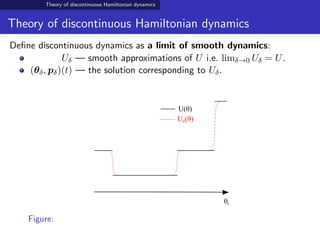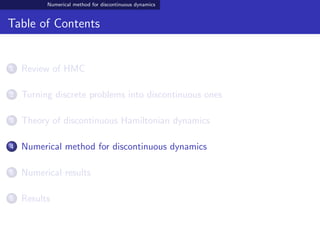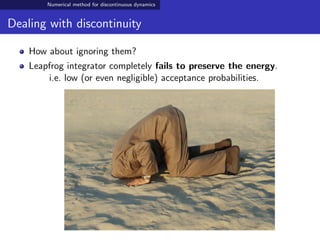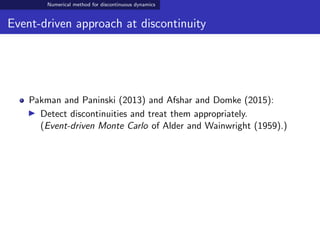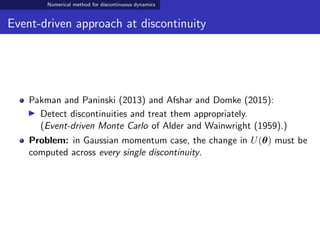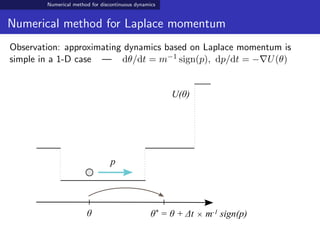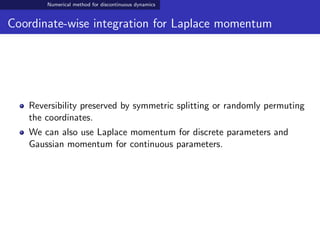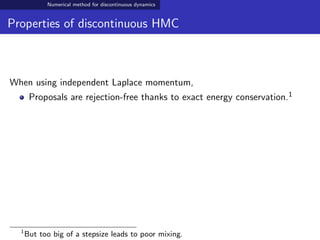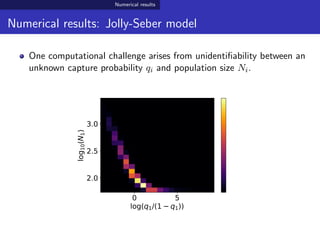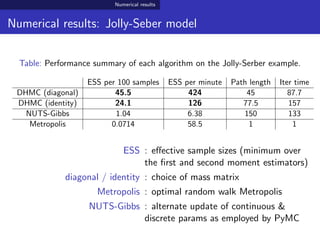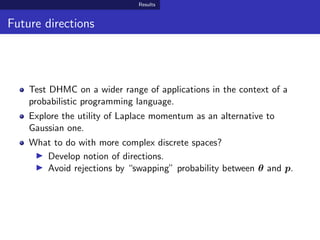QMC Program: Trends and Advances in Monte Carlo Sampling Algorithms Workshop, Discontinuous Hamiltonian Monte Carlo for Sampling Discrete Parameters - Aki Nishimura, Dec 12, 2017
- 1. Discontinuous Hamiltonian Monte Carlo for discontinuous and discrete distributions Aki Nishimura joint work with David Dunson and Jianfeng Lu SAMSI Workshop: Trends and Advances in Monte Carlo Sampling Algorithms December 12, 2017
- 2. Models with discrete params / discontinuous likelihoods Discrete : unknown population size, change points Discontinuous : nonparametric generalized Bayes, threshold effects
- 3. Hamiltonian Monte Carlo (HMC) for Bayesian computation Bayesian inference often relies on Markov chain Monte Carlo. HMC has become popular as an efficient general-purpose algorithm: allows for more flexible generative models (e.g. non-conjugacy). a critical building block of probabilistic programming languages.
- 4. Hamiltonian Monte Carlo (HMC) for Bayesian computation Idea of a probabilistic programming language: you specify the model, then the software takes care of the rest.
- 5. Hamiltonian Monte Carlo (HMC) for Bayesian computation Idea of a probabilistic programming language: you specify the model, then the software takes care of the rest. Probabilistic programming languages can algorithmically evaluate (unnormalized) log posterior density. (unnormalized) log conditional densities efficiently by taking advantage of conditional independence structure. gradients of log density.
- 6. Hamiltonian Monte Carlo (HMC) for Bayesian computation Idea of a probabilistic programming language: you specify the model, then the software takes care of the rest. Probabilistic programming languages can algorithmically evaluate (unnormalized) log posterior density. (unnormalized) log conditional densities efficiently by taking advantage of conditional independence structure. gradients of log density. HMC is well-suited to such softwares and has demonstrated a number of empirical successes e.g. through Stan and PyMC. better theoretical scalability in the number of parameters (Beskos et al., 2013).
- 7. HMC and discrete parameters / discontinuous likelihoods HMC is based on solutions of an ordinary differential equation. But the ODE makes no sense for discrete parameters / discontinuous likelihoods.
- 8. HMC and discrete parameters / discontinuous likelihoods HMC is based on solutions of an ordinary differential equation. But the ODE makes no sense for discrete parameters / discontinuous likelihoods. HMC’s inability to handle discrete parameters is considered the most serious drawback (Gelman et al., 2015; Monnahan et al., 2016).
- 9. HMC and discrete parameters / discontinuous likelihoods HMC is based on solutions of an ordinary differential equation. But the ODE makes no sense for discrete parameters / discontinuous likelihoods. HMC’s inability to handle discrete parameters is considered the most serious drawback (Gelman et al., 2015; Monnahan et al., 2016). Existing approaches in special cases: smooth surrogate function for binary pairwise Markov random field models (Zhang et al., 2012). treat discrete parameters as continuous if the likelihood still makes sense (Berger et al., 2012).
- 10. Our approach: discontinous HMC Features: allows for a discontinuous target distribution. handles discrete parameters through embedding them into a continuous space. fits within the framework of probabilistic programming languages.
- 11. Our approach: discontinous HMC Features: allows for a discontinuous target distribution. handles discrete parameters through embedding them into a continuous space. fits within the framework of probabilistic programming languages. Techniques: is motivated by theory of measure-valued differential equation & event-driven Monte Carlo. is based on a novel numerical method for discontinuous dynamics.
- 12. Our approach: discontinous HMC Features: allows for a discontinuous target distribution. handles discrete parameters through embedding them into a continuous space. fits within the framework of probabilistic programming languages. Techniques: is motivated by theory of measure-valued differential equation & event-driven Monte Carlo. is based on a novel numerical method for discontinuous dynamics. Theoretical properties: generalizes (and hence outperforms) variable-at-a-time Metropolis. achieves a high acceptance rate that indicates a scaling property comparable to HMC.
- 13. Review of HMC Table of Contents 1 Review of HMC 2 Turning discrete problems into discontinuous ones 3 Theory of discontinuous Hamiltonian dynamics 4 Numerical method for discontinuous dynamics 5 Numerical results 6 Results
- 14. Review of HMC HMC in its basic form HMC samples from an augmented parameter space (θ, p) where: π(θ, p) ∝ πΘ(θ) × N (p ; 0, mI) U(θ) = − log πΘ(θ) is called potential energy.
- 15. Review of HMC HMC in its basic form HMC samples from an augmented parameter space (θ, p) where: π(θ, p) ∝ πΘ(θ) × N (p ; 0, mI) U(θ) = − log πΘ(θ) is called potential energy. Transition rule of HMC Given the current state (θ0, p0), HMC generates the next state as follows: 1 Re-sample p0 ∼ N (0, mI) 2 Generate a Metropolis proposal by solving Hamilton’s equation: dθ dt = m−1 p, dp dt = − θU(θ) (1) with the initial condition (θ0, p0). 3 Accept or reject the proposal.
- 16. Review of HMC HMC in its basic form HMC samples from an augmented parameter space (θ, p) where: π(θ, p) ∝ πΘ(θ) × N (p ; 0, mI) U(θ) = − log πΘ(θ) is called potential energy. Transition rule of HMC Given the current state (θ0, p0), HMC generates the next state as follows: 1 Re-sample p0 ∼ N (0, mI) 2 Generate a Metropolis proposal by solving Hamilton’s equation: dθ dt = m−1 p, dp dt = − θU(θ) (1) with the initial condition (θ0, p0). 3 Accept or reject the proposal. Interpretation of (1): dθ dt = velocity, mass × d dt (velocity) = − θU(θ)
- 17. Review of HMC Visual illustration: HMC in action HMC for a 2d Gaussian (correlation = 0.9)
- 18. Review of HMC HMC in a more general form HMC samples from an augmented parameter space (θ, p) where: π(θ, p) ∝ πΘ(θ) × πP (p) K(p) = − log πP (p) is called kinetic energy. Transition rule of HMC Given the current state (θ0, p0), HMC generates the next state as follows: 1 Re-sample p0 ∼ πP (·). 2 Generate a Metropolis proposal by solving Hamilton’s equation: dθ dt = pK(p) dp dt = − θU(θ) (2) with the initial condition (θ0, p0). 3 Accept or reject the proposal.
- 19. Review of HMC Properties of Hamiltonian dynamics Conservation of energy: U(θ(t)) + K(p(t)) = U(θ0) + K(p0) for all t ∈ R a basis for high acceptance probabilities of HMC proposals.
- 20. Review of HMC Properties of Hamiltonian dynamics Conservation of energy: U(θ(t)) + K(p(t)) = U(θ0) + K(p0) for all t ∈ R a basis for high acceptance probabilities of HMC proposals. Reversibility & Volume-preservation symmetry of proposals “P(x → x∗) = P(x∗ → x)”
- 21. Turning discrete problems into discontinuous ones Table of Contents 1 Review of HMC 2 Turning discrete problems into discontinuous ones 3 Theory of discontinuous Hamiltonian dynamics 4 Numerical method for discontinuous dynamics 5 Numerical results 6 Results
- 22. Turning discrete problems into discontinuous ones Turning discrete problem into discontinuous one Consider a discrete parameter N ∈ Z+ with a prior πN (·). Map N into a continuous parameter N such that N = n if and only if N ∈ (an, an+1] To match the distribution of N, the corresponding density of N is πN (˜n) = n≥1 πN (n) an+1 − an 1{an < ˜n ≤ an+1}
- 23. Turning discrete problems into discontinuous ones Turning discrete problem into discontinuous one 0 2 4 6 8 10 n 0.0 0.2 0.4 0.6 Massfunction pmf (n+1) 2 0 2 4 6 8 10 n 0.0 0.2 0.4 0.6 Density log-scale embedding linear-scale embedding Figure: Relating a discrete mass function (left) to a density function (right).
- 24. Turning discrete problems into discontinuous ones What about more complex discrete spaces? Graphs? Trees? For “momentum” to be useful, we need a notion of direction.
- 25. Turning discrete problems into discontinuous ones What about more complex discrete spaces? Short answer: I don’t know. (Let me know if you got ideas.) Graphs? Trees? For “momentum” to be useful, we need a notion of direction.
- 26. Theory of discontinuous Hamiltonian dynamics Table of Contents 1 Review of HMC 2 Turning discrete problems into discontinuous ones 3 Theory of discontinuous Hamiltonian dynamics 4 Numerical method for discontinuous dynamics 5 Numerical results 6 Results
- 27. Theory of discontinuous Hamiltonian dynamics Theory of discontinuous Hamiltonian dynamics When U(θ) = − log π(θ) is discontinuous, Hamilton’s equations dθ dt = pK(p) dp dt = − θU(θ) (3) becomes a measure-valued differential equation / inclusion. θi U(θ) Figure:
- 28. Theory of discontinuous Hamiltonian dynamics Theory of discontinuous Hamiltonian dynamics Define discontinuous dynamics as a limit of smooth dynamics: Uδ — smooth approximations of U i.e. limδ→0 Uδ = U. (θδ, pδ)(t) — the solution corresponding to Uδ. θi U(θ) Uδ(θ) Figure:
- 29. Theory of discontinuous Hamiltonian dynamics Theory of discontinuous Hamiltonian dynamics Define discontinuous dynamics as a limit of smooth dynamics: Uδ — smooth approximations of U i.e. limδ→0 Uδ = U. (θδ, pδ)(t) — the solution corresponding to Uδ. (θ, p)(t) := limδ→0(θδ, pδ)(t). θi U(θ) Uδ(θ) Figure: Example trajectory θ(t) of discontinuous Hamiltonian dynamics.
- 30. Theory of discontinuous Hamiltonian dynamics Behavior of dynamics at discontinuity When the trajectory θ(t) encounters a discontinuity of U at event time te, the momentum p(t) undergoes an instantaneous change.
- 31. Theory of discontinuous Hamiltonian dynamics Behavior of dynamics at discontinuity When the trajectory θ(t) encounters a discontinuity of U at event time te, the momentum p(t) undergoes an instantaneous change. The change in p occurs only in the direction of “− θU(θ)”: p(t+ e ) = p(t− e ) − γ ν (θ(te)) where ν(θ) is orthonormal to the discontinuity boundary of U.
- 32. Theory of discontinuous Hamiltonian dynamics Behavior of dynamics at discontinuity When the trajectory θ(t) encounters a discontinuity of U at event time te, the momentum p(t) undergoes an instantaneous change. The change in p occurs only in the direction of “− θU(θ)”: p(t+ e ) = p(t− e ) − γ ν (θ(te)) where ν(θ) is orthonormal to the discontinuity boundary of U. The scalar γ is determined by the energy conservation principle: K(p(t+ e )) − K(p(t− e )) = U(θ(t− e )) − U(θ(t+ e )) (provided K(p) is convex and K(p) → ∞ as p → ∞).
- 33. Numerical method for discontinuous dynamics Table of Contents 1 Review of HMC 2 Turning discrete problems into discontinuous ones 3 Theory of discontinuous Hamiltonian dynamics 4 Numerical method for discontinuous dynamics 5 Numerical results 6 Results
- 34. Numerical method for discontinuous dynamics Dealing with discontinuity
- 35. Numerical method for discontinuous dynamics Dealing with discontinuity How about ignoring them?
- 36. Numerical method for discontinuous dynamics Dealing with discontinuity How about ignoring them? Leapfrog integrator completely fails to preserve the energy. i.e. low (or even negligible) acceptance probabilities.
- 37. Numerical method for discontinuous dynamics Event-driven approach at discontinuity Pakman and Paninski (2013) and Afshar and Domke (2015): Detect discontinuities and treat them appropriately. (Event-driven Monte Carlo of Alder and Wainwright (1959).)
- 38. Numerical method for discontinuous dynamics Event-driven approach at discontinuity Pakman and Paninski (2013) and Afshar and Domke (2015): Detect discontinuities and treat them appropriately. (Event-driven Monte Carlo of Alder and Wainwright (1959).) Problem: in Gaussian momentum case, the change in U(θ) must be computed across every single discontinuity.
- 39. Numerical method for discontinuous dynamics Problem with Gaussian momentum & existing approach Say var(N) ≈ 1, 000. Then a Metropolis step N → N ± 1, 000 should have a good chance of acceptance. The numerical method requires 1, 000 density evaluations (ouch!) for a corresponding transition. ΔU ≈ .01 Figure: Conditional distribution of an embedded discrete parameter in the Jolly-Seber example.
- 40. Numerical method for discontinuous dynamics Laplace momentum: better alternative Consider a Laplace momentum π(p) ∝ i exp(−m−1 i |pi|). The corresponding Hamilton’s equation is dθ dt = m−1 · sign(p), dp dt = − θU(θ)
- 41. Numerical method for discontinuous dynamics Laplace momentum: better alternative Consider a Laplace momentum π(p) ∝ i exp(−m−1 i |pi|). The corresponding Hamilton’s equation is dθ dt = m−1 · sign(p), dp dt = − θU(θ) Key property: the velocity dθ/dt depends only on the signs of pi’s and not on their magnitudes. This property allows an accurate numerical approximation without keeping track of small changes in pi’s.
- 42. Numerical method for discontinuous dynamics Numerical method for Laplace momentum Observation: approximating dynamics based on Laplace momentum is simple in a 1-D case — dθ/dt = m−1 sign(p), dp/dt = − U(θ) θ θ* = θ + Δt × m-1 sign(p) U(θ) p
- 43. Numerical method for discontinuous dynamics Numerical method for Laplace momentum Observation: approximating dynamics based on Laplace momentum is simple in a 1-D case — dθ/dt = m−1 sign(p), dp/dt = − U(θ) θ θ* = θ + Δt × m-1 sign(p) U(θ) p U(θ*) − U(θ) < K(p) ?
- 44. Numerical method for discontinuous dynamics Numerical method for Laplace momentum Observation: approximating dynamics based on Laplace momentum is simple in a 1-D case — dθ/dt = m−1 sign(p), dp/dt = − U(θ) θ θ* = θ + Δt × m-1 sign(p) U(θ) U(θ*) − U(θ) = K(p) − K(p*) p*
- 45. Numerical method for discontinuous dynamics Numerical method for Laplace momentum Observation: approximating dynamics based on Laplace momentum is simple in a 1-D case — dθ/dt = m−1 sign(p), dp/dt = − U(θ) θ θ* U(θ*) − U(θ) p
- 46. Numerical method for discontinuous dynamics Numerical method for Laplace momentum Observation: approximating dynamics based on Laplace momentum is simple in a 1-D case — dθ/dt = m−1 sign(p), dp/dt = − U(θ) p* ← - p θ* ← θ
- 47. Numerical method for discontinuous dynamics Coordinate-wise integration for Laplace momentum For θ ∈ Rd, we can split the ODE into its coordinate-wise component: dθi dt = m−1 i sign(pi), dpi dt = −∂θi U(θ), dθ−i dt = dp−i dt = 0 (4)
- 48. Numerical method for discontinuous dynamics Coordinate-wise integration for Laplace momentum 4 2 0 2 4 2 0 2 4 0 1 2 3 4 5 Figure: Trajectory of a numerical solution via the coordinate-wise integrator.
- 49. Numerical method for discontinuous dynamics Coordinate-wise integration for Laplace momentum Reversibility preserved by symmetric splitting or randomly permuting the coordinates. We can also use Laplace momentum for discrete parameters and Gaussian momentum for continuous parameters.
- 50. Numerical method for discontinuous dynamics Properties of discontinuous HMC When using independent Laplace momentum, Proposals are rejection-free thanks to exact energy conservation.1 1 But too big of a stepsize leads to poor mixing.
- 51. Numerical method for discontinuous dynamics Properties of discontinuous HMC When using independent Laplace momentum, Proposals are rejection-free thanks to exact energy conservation.1 Taking one numerical integration step of DHMC ≡ Variable-at-a-time Metropolis. 1 But too big of a stepsize leads to poor mixing.
- 52. Numerical method for discontinuous dynamics Properties of discontinuous HMC When using independent Laplace momentum, Proposals are rejection-free thanks to exact energy conservation.1 Taking one numerical integration step of DHMC ≡ Variable-at-a-time Metropolis. When mixing Laplace and Gaussian momentum: Errors in energy is O(∆t2), and hence 1 − O(∆t4) acceptance rate. 1 But too big of a stepsize leads to poor mixing.
- 53. Numerical results Table of Contents 1 Review of HMC 2 Turning discrete problems into discontinuous ones 3 Theory of discontinuous Hamiltonian dynamics 4 Numerical method for discontinuous dynamics 5 Numerical results 6 Results
- 54. Numerical results Numerical results: Jolly-Seber (capture-recapture) model Data : the number of marked / unmarked individuals over multiple capture occasions Parameters : population sizes, capture probabilities, survival rates
- 55. Numerical results Numerical results: Jolly-Seber model One computational challenge arises from unidentifiability between an unknown capture probability qi and population size Ni. 0 5 log(q1/(1 q1)) 2.0 2.5 3.0 log10(N1)
- 56. Numerical results Numerical results: Jolly-Seber model Table: Performance summary of each algorithm on the Jolly-Serber example. ESS per 100 samples ESS per minute Path length Iter time DHMC (diagonal) 45.5 424 45 87.7 DHMC (identity) 24.1 126 77.5 157 NUTS-Gibbs 1.04 6.38 150 133 Metropolis 0.0714 58.5 1 1 ESS : effective sample sizes (minimum over the first and second moment estimators) diagonal / identity : choice of mass matrix Metropolis : optimal random walk Metropolis NUTS-Gibbs : alternate update of continuous & discrete params as employed by PyMC
- 57. Numerical results Numerical results: generalized Bayesian inference For a given loss function (y, θ) of interest, a generalized posterior (Bissiri et al., 2016) is given by πpost(θ) ∝ exp − i (yi, θ) πprior(θ) We consider a binary classification with the 0-1 loss (y, θ) = 1{y = sign(x θ)} for y ∈ {−1, 1}.
- 58. Numerical results Numerical results: generalized Bayesian inference For a given loss function (y, θ) of interest, a generalized posterior (Bissiri et al., 2016) is given by πpost(θ) ∝ exp − i (yi, θ) πprior(θ) We consider a binary classification with the 0-1 loss (y, θ) = 1{y = sign(x θ)} for y ∈ {−1, 1}. 9.2 9.0 8.8 Intercept 0 2 4 6 Density(conditional)
- 59. Numerical results Numerical results: generalized Bayesian inference Data: semiconductor quality with various sensor measurements Goal: predict faulty products / infer relevant sensor measurements
- 60. Numerical results Numerical results: generalized Bayesian inference Table: Performance summary on the generalized Bayesian posterior example. ESS per 100 samples ESS per minute Path length Iter time DHMC 26.3 76 25 972 Metropolis 0.00809 (± 0.0018) 0.227 1 1 Variable-at-a-time 0.514 (± 0.039) 39.8 1 36.2 9.2 9.0 8.8 Intercept 0 2 4 6 Density(conditional)
- 61. Results Table of Contents 1 Review of HMC 2 Turning discrete problems into discontinuous ones 3 Theory of discontinuous Hamiltonian dynamics 4 Numerical method for discontinuous dynamics 5 Numerical results 6 Results
- 62. Results Summary Hamiltonian dynamics based on Laplace momentum allows an efficient exploration of discontinuous target distributions. Numerical method with exact energy conservation property.
- 63. Results Future directions Test DHMC on a wider range of applications in the context of a probabilistic programming language. Explore the utility of Laplace momentum as an alternative to Gaussian one. What to do with more complex discrete spaces? Develop notion of directions. Avoid rejections by “swapping” probability between θ and p.
- 64. Results References Nishimura, A., Dunson, D. and Lu, J. (2017) “Discontinuous Hamiltonian Monte Carlo for sampling discrete parameters,” arXiv:1705.08510. Code available at https://github.com/aki-nishimura/discontinuous-hmc







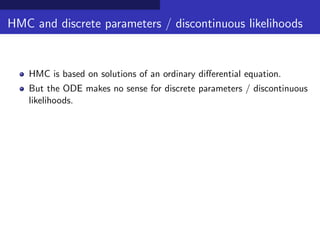






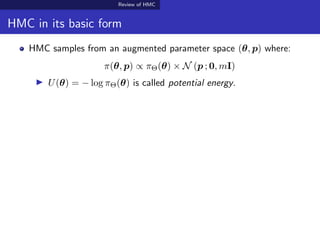







![Turning discrete problems into discontinuous ones
Turning discrete problem into discontinuous one
Consider a discrete parameter N ∈ Z+ with a prior πN (·).
Map N into a continuous parameter N such that
N = n if and only if N ∈ (an, an+1]
To match the distribution of N, the corresponding density of N is
πN
(˜n) =
n≥1
πN (n)
an+1 − an
1{an < ˜n ≤ an+1}](https://image.slidesharecdn.com/samsinishimura-171215212059/85/QMC-Program-Trends-and-Advances-in-Monte-Carlo-Sampling-Algorithms-Workshop-Discontinuous-Hamiltonian-Monte-Carlo-for-Sampling-Discrete-Parameters-Aki-Nishimura-Dec-12-2017-22-320.jpg)





